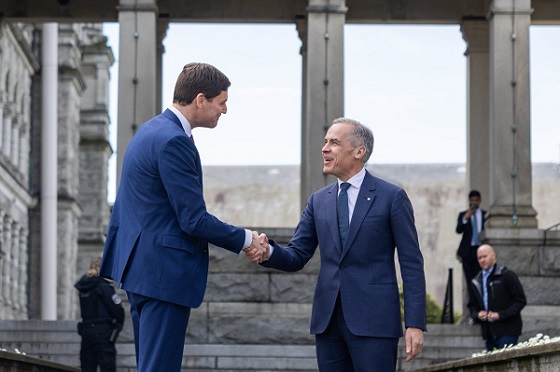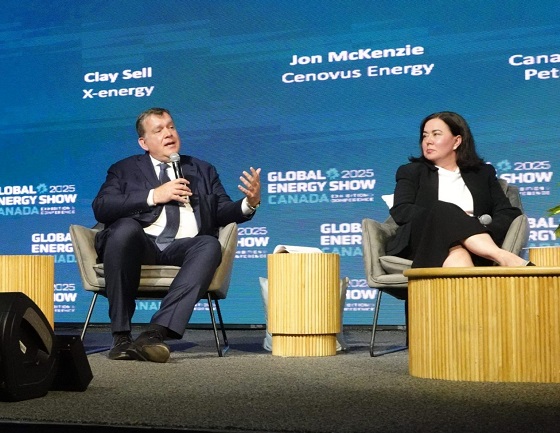Canadian Energy Centre
These three Indigenous women are leading the future of Canadian LNG

Crystal Smith, chief councillor of the Haisla Nation, Karen Ogen, CEO of the First Nations LNG Alliance, and Eva Clayton, president of the Nisga’a Nation.
From the Canadian Energy Centre
‘By being owners in these projects, we can meaningfully contribute to a cleaner and more just world’
Three female Indigenous leaders in British Columbia are leading the future of Canadian LNG.
Eva Clayton is president of the Nisga’a Nation, a joint venture partner in the proposed Ksi Lisims LNG project. Karen Ogen, former elected chief of the Wet’suwet’en First Nation, is CEO of the First Nations LNG Alliance. And Crystal Smith is elected chief of the Haisla Nation, majority owner of the proposed Cedar LNG project, which is in the final stages of preparing for the green light to proceed.
“By being owners in these projects, we can meaningfully contribute to a cleaner and more just world,” said Smith, who was first elected chief of the coastal nation in 2017, during the B.C. Natural Resources Forum earlier this year.
“From an Indigenous perspective, we’re continuously taught to take care of our environment, to take care of our land, and to take only what is required. To think in a global context, I truly believe that in supporting the LNG industry, we are in fact doing that.”

Eva Clayton, back left, President of the Nisga’a Lisims Government (joint venture owner of the proposed Ksi Lisims LNG project), Crystal Smith, back right, Haisla Nation Chief Councillor (joint venture owner of proposed Cedar LNG project), and Karen Ogen, front right, CEO of the First Nations LNG Alliance pose for a photograph on the HaiSea Wamis zero-emission tugboat outside the LNG2023 conference, in Vancouver, B.C., Monday, July 10, 2023. CP Images photo
The global liquefied natural gas industry is rising in importance as emerging economies in Asia look to move away from coal-fired power and European nations reduce reliance on Russia
In 2023, LNG demand reached a record 404 million tonnes, according to Shell’s latest industry outlook. Over the next two decades it is expected to rise by nearly 70 per cent, reaching 685 million tonnes by 2040.
Canada’s first LNG export terminal – located on Haisla territory – is nearing completion and preparing for startup next year.
Smith said the nation has seen great benefits from its support of the LNG Canada project, but owning Cedar LNG with partner Pembina Pipeline Corporation takes the opportunity to a new level.
“We have a bigger vision that provides better education, better health care, better justice, and a better future for our people,” she said.
“We can train our people with the skills needed to secure well-paying, family supporting jobs on Cedar LNG and other projects. We can build critical community infrastructure like our new health center and our youth center in Haisla territory.”
Smith said LNG is helping fund programs that reconnect Haisla people with their culture and language, “a language that virtually disappeared with my generation.”
“We are reigniting our potential through culture and language. And that is perhaps the most powerful thing of all. When I think of my daughter speaking Haisla with my grandchildren, that is what drives me each and every day.”
To the north in the Nass Valley, near B.C.’s border with Alaska, Clayton said the Nisga’a Nation is also using its partnerships in LNG to reconnect with language and culture.
The community owns Ksi Lisims along with Rockies LNG (a coalition of Canadian natural gas producers) and Texas-based developer Western LNG.

Construction of the LNG Canada export terminal is now more than 90 per cent complete. Photo courtesy LNG Canada
“The cultural benefits for the Nisga’a Nation will only be more enhanced as we move forward with the project,” said Clayton, who was first elected president of the community in 2016.
“There are ongoing programs that are in place so that our people and our young people will continue to speak the language. What I’ve noticed is that many of our elders that have been teaching this language are aging out. And so now we see a new generation of young people coming up to speak the language and teach language.”
In B.C.’s central interior, the Wet’suwet’en Nation is facing a loss of culture and language, Ogen said. It’s a situation that can be helped with the economic opportunities of LNG.
“We’re at a place in our community since the pandemic where we have maybe one or two fluent speakers left. That’s really not good news,” said Ogen, who served as chief from 2010 to 2016.
“We want to be able to promote our language in our community and continue promoting our culture in our community because we have very few people in my generation that have traditional names.”
Partnering in development projects like the recently completed Coastal GasLink pipeline (which will supply natural gas to the LNG Canada terminal as well as Cedar LNG) helps communities with access to clean drinking water, housing, health, wellness and education, Ogen said.
She helped found the First Nations LNG Alliance in 2015 with the goal to educate communities about the potential benefits of development.

As construction on Coastal GasLink winds down, crews are working to cleanup and reclaim the land. Clay and topsoil removed during construction has been stored on site and will now be used to contour the land to its previous shape to re-establish original drainage patterns. Photo courtesy Coastal GasLink
“I’ve learned a lot in this job. Being a girl from the rez, being a social worker, and then getting into this field, it’s something I didn’t aspire to. But for me, I’m passionate about it because of what it means to our people on the ground,” she said.
Ogen has shared that message internationally, including during a trade mission to China last fall. The smog from burning coal in Beijing heightened her conviction about the benefits of Canadian LNG in Asia, she said.
“We were given a presentation on how China still wants B.C.’s natural resources; they still want our LNG,” Ogen said.
“B.C. and Canada need to hear those loud messages because we’re at an economic opportunity that’ll help us address the greenhouse gas emissions globally.”
Clayton said she has heard the same thing.
“The messaging that I get from the international world is that they need our LNG. The Germans, Japanese, all of them are wondering why they’re not getting gas from their allies. We have a responsibility as Canadians to help the world get off of coal,” she said.
“We are working together for the benefit of our children. These major projects, every decision that we make is for the future of our children, the future of Canada, the world really when you think about the kind of industry we’re getting into, LNG.”
Smith’s Cedar LNG could be the first Indigenous-led project in the world. Pembina Pipeline plans to spend up to $300 million advancing it to a final investment decision by mid-year.
“Every time I hear about it, I literally start shaking and getting goosebumps. I’ll have many sleepless nights from now until that decision is made,” Smith said.
“Our nation has had the ability to benefit from LNG development in our territory, but let’s not let it be the last.
“There are so many other LNG projects with indigenous leadership in B.C. that have the potential to make a significant impact on the future of Indigenous people and also help fight climate change.”
Canadian Energy Centre
Cross-Canada economic benefits of the proposed Northern Gateway Pipeline project

From the Canadian Energy Centre
Billions in government revenue and thousands of jobs across provinces
Announced in 2006, the Northern Gateway project would have built twin pipelines between Bruderheim, Alta. and a marine terminal at Kitimat, B.C.
One pipeline would export 525,000 barrels per day of heavy oil from Alberta to tidewater markets. The other would import 193,000 barrels per day of condensate to Alberta to dilute heavy oil for pipeline transportation.
The project would have generated significant economic benefits across Canada.

The following projections are drawn from the report Public Interest Benefits of the Northern Gateway Project (Wright Mansell Research Ltd., July 2012), which was submitted as reply evidence during the regulatory process.
Financial figures have been adjusted to 2025 dollars using the Bank of Canada’s Inflation Calculator, with $1.00 in 2012 equivalent to $1.34 in 2025.
Total Government Revenue by Region
Between 2019 and 2048, a period encompassing both construction and operations, the Northern Gateway project was projected to generate the following total government revenues by region (direct, indirect and induced):

British Columbia
- Provincial government revenue: $11.5 billion
- Federal government revenue: $8.9 billion
- Total: $20.4 billion
Alberta
- Provincial government revenue: $49.4 billion
- Federal government revenue: $41.5 billion
- Total: $90.9 billion
Ontario
- Provincial government revenue: $1.7 billion
- Federal government revenue: $2.7 billion
- Total: $4.4 billion
Quebec
- Provincial government revenue: $746 million
- Federal government revenue: $541 million
- Total: $1.29 billion
Saskatchewan
- Provincial government revenue: $6.9 billion
- Federal government revenue: $4.4 billion
- Total: $11.3 billion
Other
- Provincial government revenue: $1.9 billion
- Federal government revenue: $1.4 billion
- Total: $3.3 billion
Canada
- Provincial government revenue: $72.1 billion
- Federal government revenue: $59.4 billion
- Total: $131.7 billion
Annual Government Revenue by Region
Over the period 2019 and 2048, the Northern Gateway project was projected to generate the following annual government revenues by region (direct, indirect and induced):

British Columbia
- Provincial government revenue: $340 million
- Federal government revenue: $261 million
- Total: $601 million per year
Alberta
- Provincial government revenue: $1.5 billion
- Federal government revenue: $1.2 billion
- Total: $2.7 billion per year
Ontario
- Provincial government revenue: $51 million
- Federal government revenue: $79 million
- Total: $130 million per year
Quebec
- Provincial government revenue: $21 million
- Federal government revenue: $16 million
- Total: $37 million per year
Saskatchewan
- Provincial government revenue: $204 million
- Federal government revenue: $129 million
- Total: $333 million per year
Other
- Provincial government revenue: $58 million
- Federal government revenue: $40 million
- Total: $98 million per year
Canada
- Provincial government revenue: $2.1 billion
- Federal government revenue: $1.7 billion
- Total: $3.8 billion per year
Employment by Region
Over the period 2019 to 2048, the Northern Gateway Pipeline was projected to generate the following direct, indirect and induced full-time equivalent (FTE) jobs by region:

British Columbia
- Annual average: 7,736
- Total over the period: 224,344
Alberta
- Annual average: 11,798
- Total over the period: 342,142
Ontario
- Annual average: 3,061
- Total over the period: 88,769
Quebec
- Annual average: 1,003
- Total over the period: 29,087
Saskatchewan
- Annual average: 2,127
- Total over the period: 61,683
Other
- Annual average: 953
- Total over the period: 27,637
Canada
- Annual average: 26,678
- Total over the period: 773,662
Business
Natural gas pipeline ownership spreads across 36 First Nations in B.C.

Chief David Jimmie is president of Stonlasec8 and Chief of Squiala First Nation in B.C. He also chairs the Western Indigenous Pipeline Group. Photo courtesy Western Indigenous Pipeline Group
From the Canadian Energy Centre
Stonlasec8 agreement is Canada’s first federal Indigenous loan guarantee
The first federally backed Indigenous loan guarantee paves the way for increased prosperity for 36 First Nations communities in British Columbia.
In May, Canada Development Investment Corporation (CDEV) announced a $400 million backstop for the consortium to jointly purchase 12.5 per cent ownership of Enbridge’s Westcoast natural gas pipeline system for $712 million.
In the works for two years, the deal redefines long-standing relationships around a pipeline that has been in operation for generations.
“For 65 years, there’s never been an opportunity or a conversation about participating in an asset that’s come through the territory,” said Chief David Jimmie of the Squiala First Nation near Vancouver, B.C.
“We now have an opportunity to have our Nation’s voices heard directly when we have concerns and our partners are willing to listen.”
Jimmie chairs the Stonlasec8 Indigenous Alliance, which represents the communities buying into the Enbridge system.
The name Stonlasec8 reflects the different regions represented in the agreement, he said.
The Westcoast pipeline stretches more than 2,900 kilometres from northeast B.C. near the Alberta border to the Canada-U.S. border near Bellingham, Wash., running through the middle of the province.

It delivers up to 3.6 billion cubic feet per day of natural gas throughout B.C. and the Lower Mainland, Alberta and the U.S. Pacific Northwest.
“While we see the benefits back to communities, we are still reminded of our responsibility to the land, air and water so it is important to think of reinvestment opportunities in alternative energy sources and how we can offset the carbon footprint,” Jimmie said.
He also chairs the Western Indigenous Pipeline Group (WIPG), a coalition of First Nations communities working in partnership with Pembina Pipeline to secure an ownership stake in the newly expanded Trans Mountain pipeline system.
There is overlap between the communities in the two groups, he said.
CDEV vice-president Sébastien Labelle said provincial models such as the Alberta Indigenous Opportunities Corporation (AIOC) and Ontario’s Indigenous Opportunities Financing Program helped bring the federal government’s version of the loan guarantee to life.
“It’s not a new idea. Alberta started it before us, and Ontario,” Labelle said.
“We hired some of the same advisors AIOC hired because we want to make sure we are aligned with the market. We didn’t want to start something completely new.”
Broadly, Jimmie said the Stonlasec8 agreement will provide sustained funding for investments like housing, infrastructure, environmental stewardship and cultural preservation. But it’s up to the individual communities how to spend the ongoing proceeds.
The long-term cash injections from owning equity stakes of major projects can provide benefits that traditional funding agreements with the federal government do not, he said.
Labelle said the goal is to ensure Indigenous communities benefit from projects on their traditional territories.
“There’s a lot of intangible, indirect things that I think are hugely important from an economic perspective,” he said.
“You are improving the relationship with pipeline companies, you are improving social license to do projects like this.”
Jimmie stressed the impact the collaborative atmosphere of the negotiations had on the success of the Stonlasec8 agreement.
“It takes true collaboration to reach a successful partnership, which doesn’t always happen. And from the Nation representation, the sophistication of the group was one of the best I’ve ever worked with.”
-

 Health22 hours ago
Health22 hours agoLast day and last chance to win this dream home! Support the 2025 Red Deer Hospital Lottery before midnight!
-

 Business2 days ago
Business2 days agoCarney’s European pivot could quietly reshape Canada’s sovereignty
-

 Alberta2 days ago
Alberta2 days agoAlberta’s grand bargain with Canada includes a new pipeline to Prince Rupert
-

 conflict1 day ago
conflict1 day ago“Evacuate”: Netanyahu Warns Tehran as Israel Expands Strikes on Iran’s Military Command
-

 Aristotle Foundation1 day ago
Aristotle Foundation1 day agoThe Canadian Medical Association’s inexplicable stance on pediatric gender medicine
-

 Energy1 day ago
Energy1 day agoCould the G7 Summit in Alberta be a historic moment for Canadian energy?
-

 Crime1 day ago
Crime1 day agoMinnesota shooter arrested after 48-hour manhunt
-

 Bruce Dowbiggin1 day ago
Bruce Dowbiggin1 day agoWOKE NBA Stars Seems Natural For CDN Advertisers. Why Won’t They Bite?





